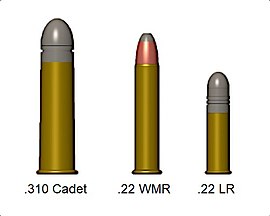Rifle cartridge
| .310 Cadet |
|---|
 |
| Type | Rifle |
|---|
| Place of origin | United Kingdom |
|---|
|
| Designer | W.W. Greener |
|---|
| Designed | 1900 |
|---|
| Manufacturer | Westley Richards and others |
|---|
|
| Case type | Rimmed, Straight |
|---|
| Bullet diameter | .323 in (8.2 mm) |
|---|
| Neck diameter | .327 in (8.3 mm) |
|---|
| Base diameter | .355 in (9.0 mm) |
|---|
| Rim diameter | .410 in (10.4 mm) |
|---|
| Rim thickness | .043 in (1.1 mm) |
|---|
| Case length | 1.12 in (28 mm) |
|---|
| Overall length | 1.6 in (41 mm) |
|---|
| Rifling twist | 20" |
|---|
| Primer type | Small rifle |
|---|
|
|
|
|
| Bullet mass/type |
Velocity |
Energy |
| 110 gr (7 g) SP |
1,500 ft/s (460 m/s) |
550 ft⋅lbf (750 J) |
| 120 gr (8 g) SP |
1,530 ft/s (470 m/s) |
624 ft⋅lbf (846 J) |
|
| Source(s): "Cartridges of the World"[1] |
The .310 Cadet, also known as the .310 Greener, or the .310 Martini, is a centerfire rifle cartridge, introduced in 1900 by W.W. Greener as a target round for the Martini Cadet rifle.[2] Firing a 120 grain heeled lead projectile at 1350 ft/s the round is similar in performance to the .32-20 Winchester and some rifles may chamber both rounds with some accuracy.[3]
The full metal jacketed round was used in cadet rifles in Australia and New Zealand after early 20th-century Defence Acts. In New Zealand, after the start of the Boer War, a cadet corps had been started; by 1901 it was recommended that membership be compulsory. 500 Westley-Richards miniature Martini–Henry rifles were available by October 1902 (Auckland Star), and 5000 by April 1903 (Star). Such rifles gained popularity in Australia, New Zealand and the United States when thousands of Martini Cadet rifles were sold by the Australian government after World War II.[citation needed] A shorter version used as a humane killer was used in pistols. Known as the .310 cattle killer, invented by WW Greener, it was shorter in that a .310 cadet could not be accidentally chambered into the humane killer pistol.
- ^ Barnes, Frank C. (1997) [1965]. McPherson, M.L. (ed.). Cartridges of the World (8th ed.). DBI Books. pp. 64, 91. ISBN 0-87349-178-5.
- ^ Barnes, Frank C., Cartridges of the World, 7th Edition, p305
- ^ Donnelly, John J., Handloaders Manual of Cartridge Conversions, p360
